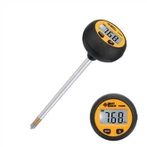Why does the electric test pen not emit light when measuring the zero line of the electric test pen?
Not only does the current flow through, but it is also equal to the current in the live wire, because the neutral wire is connected in series with the live wire and the electrical appliance, and the current in each part of the series circuit is equal. If you don't believe me, test it with an ammeter. As for why it can't be detected with the electric test pen, it is very simple, because the electric test pen is used to distinguish the live wire and the neutral wire, or to judge whether the conductor is connected to the live wire, and cannot judge whether there is current. When the metal body of the test pen tip touches the live wire or the conductor connected to the live wire, a circuit is formed from the live wire through the test pen, the human body to the earth, because there is a 220V voltage between the live wire and the earth, there is a weak current from the live wire through the test pencil and the human body Flowing to the earth, the neon tube of the test pen emits light, but it is not the same as the current in the live wire. When the metal body of the pen tip of the test pen touches the zero line, since there is no voltage between the zero line and the earth, no current will flow through the test pen, and the neon tube of the test pen will not emit light.
An Alternative Method of Using the Measuring Pen
(1) It can be used for low-voltage phase verification to measure whether any wires in the line are in phase or out of phase. The specific method is: stand on an object insulated from the earth, hold a test lead in each hand, and then test on the two wires to be tested. If the two test leads glow brightly, the two lead wires are different. On the contrary, it is the same phase, which is judged by the principle that the voltage difference between the two poles of the neon bulb in the test pen is proportional to its luminous intensity.
(2) It can be used to distinguish alternating current and direct current. When testing with a test pen, if both poles in the neon bulb of the test pen glow, it is alternating current; if only one of the two poles glows, it is direct current.
(3) It can judge the positive and negative poles of direct current. Connect the test pen to the DC circuit for testing, the pole that glows on the neon bulb is the negative pole, and the pole that does not shine is the positive pole.
(4) It can be used to judge whether the DC is grounded. In a DC system that is insulated from the ground, you can stand on the ground and touch the positive or negative pole of the DC system with a test pen. If the neon bulb of the test pen does not light up, there is no grounding phenomenon. If the neon bulb lights up, it means that there is a grounding phenomenon, and if it lights up like it is on the tip of the pen, it means that the positive electrode is grounded. If the light is on the finger end, it is the negative ground. However, it must be pointed out that in a DC system with a ground monitoring relay, this method cannot be used to determine whether the DC system is grounded.






